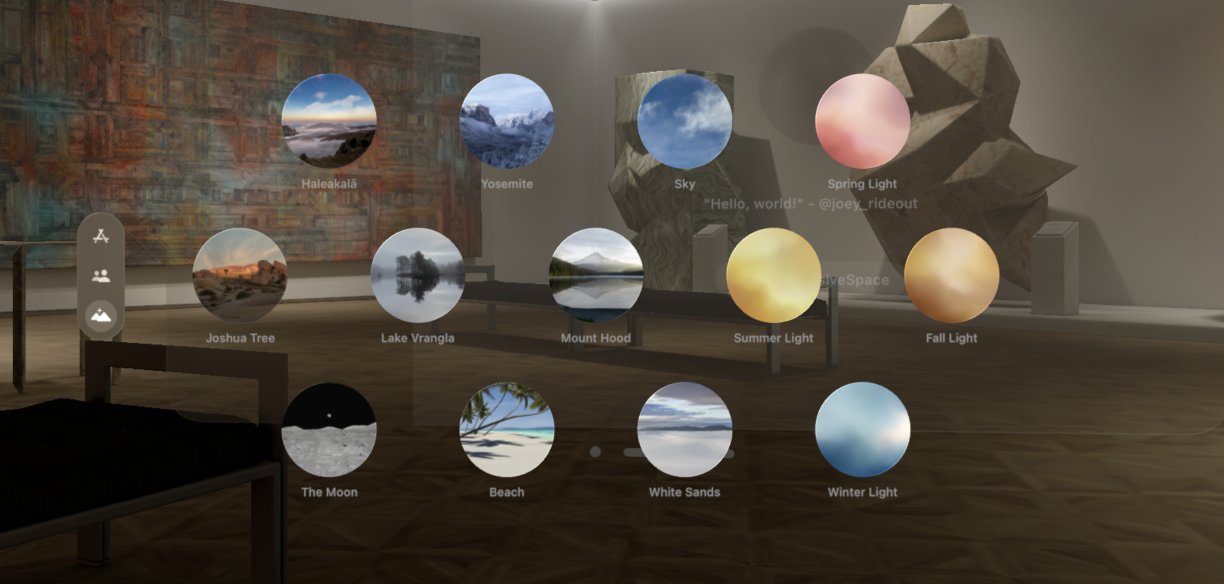Apple’s new visionOS software platform provide stunning virtual worlds that you can immerse yourself in using the Environments feature on the Vision Pro headset.

Apple has released the official visionOS software development kit for third-party developers to build spatial experiences for its AR/VR headset.
The SDK includes a Vision Pro Simulator, and Steve Moser has leveraged it to discover all the virtual scenes visionOS will offer at launch.
What scenes are included in Vision Pro’s Environments?
Apple says these virtual worlds can be used when watching movies and using other apps. The Environments feature will offer up thirteen VR scenes at launch:
- Beach
- Fall Light
- Haleakalá
- Joshua Tree
- Lake Vrangla
- Mount Hood
- Sky
- Spring Light
- Summer Light
- The Moon
- Yosemite
- White Snow
- Winter Light
These scenes are all outdoors and don’t account for changes in the time of day. Apple could expand this feature with additional 3D scenes in the future—Moser says that new scenes for the Environments feature can be downloaded.
Play with the spectrum of immersion using passthrough to blend virtual & real worlds. pic.twitter.com/XZ8vVIwuIw
— Steve Moser (@SteveMoser) June 22, 2023
Managing the Environments feature in visionOS
You can control some aspects of the Environments feature in Settings > Environments. From there, choose Appearance to control how the scenes look based on your time of day by selecting Day, Night or Automatic.

You can also adjust how loud these scenes are by dragging the slider below the Volume heading. This lets you control the volume of sounds that emit from virtual environments to suit your desired level of immersion.

The Vision Pro uses passthrough video to blend virtual and real worlds. Turning the Digital Crown makes the virtual environment take over the natural world, gradually expanding from the scene’s center to peripheral vision.
Simulated scenes for developers
Aside from the Environments feature, the visionOS SDK provides test scenes to replace the real world because the simulator doesn’t have a video passthrough.
Called Simulated Scenes, these indoor environments include settings like Kitchen, Living Room, Museum and others. They’re available in Day and Night versions.
Once you have the visionOS SDK installed you can really see how the idea of light and dark mode just doesn't make sense with Vision Pro – click the mountain icon in the bottom-right corner to try different environments, and also different times of day 🌄 pic.twitter.com/ipdlNTTDIO
— Paul Hudson (@twostraws) June 21, 2023
Because Simulated Scenes is a developer-focused feature meant for testing, it won’t be available to end users when the Vision Pro launches. According to Apple, the Simulated Scenes feature lets developers explore and test various room layouts and lighting conditions in the visionOS Simulator.
About the visionOS SDK

Apple will start accepting submissions for the visionOS App Store next month. Developers must use the official visionOS SDK, Xcode and other official tools to create, debug, test and distribute spatial apps for the AR/VR headset.
Starting today, Apple’s global community of developers will be able to create an entirely new class of spatial computing apps that take full advantage of the infinite canvas in Vision Pro and seamlessly blend digital content with the physical world to enable extraordinary new experiences. With the visionOS SDK, developers can utilize the powerful and unique capabilities of Vision Pro and visionOS to design brand-new app experiences across a variety of categories including productivity, design, gaming and more.
Interested developers will be able to get a hands-on experience with the Vision Pro at one of Apple’s labs launching in Cupertino, London, Munich, Shanghai, Singapore and Tokyo in July. The $3,500 headset is scheduled to release in early 2024.